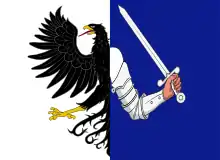Westport House
Westport House in Westport, County Mayo, Ireland, is a well known Irish tourist attraction that is owned by the Hughes family, who own a number of businesses in the west of Ireland. Until January 2017, it was the ancestral seat of the Browne family, whose head was the Marquess of Sligo. The title and the house were separated in 2014, following the death of The 11th Marquess of Sligo, who left the estate to his five daughters. His titles passed to his first cousin, Sebastian Ulick Browne, a residential estate agent in Australia.
| Westport House | |
|---|---|
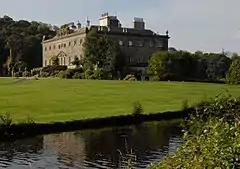 Westport House pictured in 2008 | |
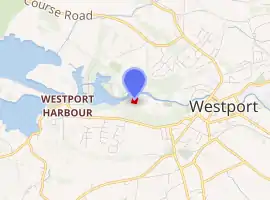
| |
| General information | |
| Town or city | Westport, County Mayo |
| Country | Ireland |
| Construction started | 1730 |
| Design and construction | |
| Architect | Richard Cassels |
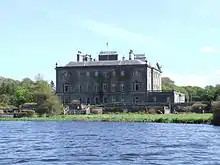
History
The house was built by the Browne family in the 18th century, near the site of an O'Malley castle. The architects were Richard Cassels, who built (1730) the east section of the house facing the town, and later James Wyatt, who built the other three façades to form a quadrangle. Later, the quadrangle was filled in with a grand staircase. North and south wings were added to the designs of Benjamin Wyatt. The south wing, which contained a library, was burned soon after it was built due to a defect in the heating system. It was subsequently rebuilt.
A model farm was built in the demesne during the early part of the 19th century, with accommodation for housing animals and animal feed. The remains of an old boathouse are open to the sea.
Colonel John Browne (1638–1711), who had the original Westport House built, married The Hon. Maud Bourke, daughter of The 3rd Viscount Mayo and the great-great-granddaughter of Gráinne Ní Mháille (Gráinne O'Malley). He was a Roman Catholic who fought on the Jacobite side in the War of the Two Kings. His descendants, however, converted to the established Church of Ireland, and prospered.
After the death of The 11th Marquess of Sligo in July 2014, the house passed to his five daughters, in accordance with private legislation passed by the Seanad in 1993.[1]
Westport House also has a Pirate Adventure Park with a Pirate Ship thrill ride, Pirates' Plunge flume ride, mini Railway, white swan pedal boats, cannonball run slippery slide, Pirate's Den indoor soft play area, dungeons, Pirate's Playground, pitch and putt, fishing, Gracy's Bar and Cafe and a large Caravan and Camping Park set in secluded woodland.
Designed by the architects Richard Cassels and James Wyatt in the 18th century, Westport House is located west of the Shannon. It is situated in a parkland setting with a lake, terraces, and garden views overlooking Clew Bay, the Atlantic Ocean, Achill, Clare Island and Ireland's Holy Mountain, Croagh Patrick. It was built and was owned by the Browne family, who are direct descendants of the 16th-century pirate queen Gráinne O'Malley.
The Brownes sold Westport House to the Hughes family, a local business family in Westport, on 17 January 2017, ending an association with Westport House lasting hundreds of years. The Hughes family plan to spend €50 million on refurbishment, which wll create over 200 new jobs on the grounds of Westport House and the Hotel this will include accommodation on the 450-acre site. This investment will bring a major boost to the town and the wider Mayo area.[2]
National Asset Management Agency (NAMA) and sale
In 2007, the privately owned estate received a grant of 1.314M Euros for repairs to Westport House, from the state funded Heritage Council.[3]
In October 2015, it was revealed that the Westport House Estate was in NAMA for debts secured on the 380-acre (150 ha) estate, but not the house, for almost 10 million Euros.[4] In January 2017, Westport House was sold to the Hughes family of Westport.[5]
Slavery links
The house was built for and owned by the Browne family, some of whom were wealthy slave and plantation owners in Jamaica. A prominent slave-owning head of the family was The 2nd Marquess of Sligo and his wife, Lady Sligo (Lady Hester Catherine de Burgh).[6] The 2nd Marquess served as Governor of Jamaica from 1834 to 1836.
An exhibition at Westport House styles The 2nd Marquess of Sligo as 'Champion of the Slaves', a suggestion that one historian refers to as 'hyperbole', pointing out that "Browne benefited from slavery from the cradle to the grave and did not free his slaves until the institution of slavery was abolished by an act of parliament", and that the 2nd Lord Sligo also claimed, and received, substantial compensation from the British Government for the loss of his slaves.[7]
The Jamaican plantations (Kellys pen' and 'Cocoa Walk') and slave workers referred to above, came into the Browne family through the marriage in 1752 of Peter Browne to Elizabeth Kelly, only daughter and heir of Denis Kelly, from Co Galway who became Chief Justice of Jamaica in th 18th century.
Howe Peter Browne, 2nd Marquess of Sligo spent the latter part of his life fighting against slavery both as Governor General of Jamaica and afterwards in the House of Lords. He is known in the history of Jamaica as 'Champion of the Slaves' and the first free slave village in the world, Sligoville, in Jamaica, is named in his honour.
Refer 'The Great Leviathan: Howe Peter Browne, 2nd Marquess of Sligo, 1788-1845' for FACTUAL details.
Irish pirate queen Gráinne Ní Mháille
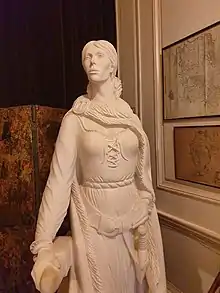
During the 16th century, Gráinne Ní Mháille or Granuaile was a famous 'pirate queen' of Connacht. After her death, a report stated that for forty years, she was the stay of all rebellions in the west. She was chief of the O'Malley Clan and ruled the seas around Mayo.
A statue of Gráinne Ní Mháille by the artist Michael Cooper is on display in Westport House, and a bronze casting of the statue is situated on the grounds near the house.
The original house was built by Colonel John Browne, a Jacobite, who was at the Siege of Limerick, and his wife Maude Bourke, who was Gráinne Ní Mháille's great-great granddaughter. The house then did not have the lake or a dam and the tide rose and fell against the walls.
Architecture
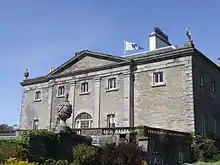
Showing 1778 date in pediment.
The east front of the house as it is today was built in 1730 by Colonel John Browne's grandson, also John – 1st Earl of Altamont, who hired the German architect Richard Cassels. It is built with the finest limestone taken from the quarry south of the estate farmyard, and was executed by craftsmen. Richard Cassels also designed Carton, Haselwood, Russborough and Leinster House. Westport House was completed by James Wyatt, one of the greatest English architects, who also laid out the town of Westport. On the south facade is the date 1778. Inside, many of the ceilings, cornice and fireplaces are examples of Wyatt's finest works. The large dining room is perhaps the finest remaining example of his work. The doors are mahogany brought back from the family estates in Jamaica. There are still a number of original Wyatt drawings on show, along with some of his son's, Benjamin Wyatt, who also did some work in the house.The wings on the north and south sides of the house were built by Wyatt junior.The staircase and enclosure of the lightwell in the middle of the house was undertaken later.The last part of the development was the creation of the terraces on the west side of the house. The original library burned down shortly after it was built due to a heating misfunction.
Art and antiques
Westport House is also unusual in that it is complete with original contents, most of which have a long association with Ireland. Among the pictures are portraits by Sir Joshua Reynolds of the 1st Earl of Altamont, of the Rt. Hon. Denis Browne, brother of the 1st Marquess of Sligo and a member of Grattan's Parliament; and by William Beechey, of Howe Peter – the 2nd Marquess of Sligo, who spent four months in an English jail for bribing British seamen in time of war to bring his ship, full of antiquities from Greece, to Westport. Howe Peter was a friend of George IV and the poet Byron. There is a portrait of Earl Howe – Admiral of the Fleet, father of the 1st Marchioness of Sligo, by John Singleton Copley. Artworks also include a collection of landscapes painted in the locality by James Arthur O'Connor. Other artists such as Chalon, Barrett, Gibson, Opie, Brooks and Lavery are part of the collection.
There is also a collection of waxwork figures by Gems Display Figures, which are a tribute to the literary, arts and music achievements of west Ireland, including William Butler Yeats, Lady Gregory and Turlough Carolan.
Other original items on show in Westport House are a fine collection of old English and Irish silver, which include some 18th-century Irish "potato" or dish rings; Waterford glass; a library with many old Irish books and the Mayo Legion Flag which was brought to Ireland by General Humbert when he invaded the country in 1798, and which has been in Westport House since. Westport House was occupied by General Humbert's troops.
Browne family
The story of Westport House and the Browne family is a microcosm for the wider and, at times, turbulent history of Ireland. Each generation had to contend with and adapt to the prevailing social, political and religious changes encountered along the way. The Browne family remained the owners of Westport House for almost three hundred years, until 17 January 2017.
The Browne family came to County Mayo from Sussex, England, in the sixteenth century. Through marriage with the daughters of native Irish landowners and by purchase they built up a small estate near The Neale. As a Catholic family they were fortunate that their lands were situated in Connacht, thereby escaping the notorious confiscations of Cromwell.
It was with John Browne III (1638–1711) that the connection with Westport House commenced. A successful lawyer, he married The Hon. Maud Bourke, daughter of The 3rd Viscount Mayo and great-great granddaughter of 'the Pirate Queen', Granuaile (Gráinne Ní Mháille or Gráinne O'Malley; 1530–1603). Browne greatly increased his estate in Mayo and Galway including Cathair-na-Mart (the Fort of the Beeves), a ruinous O'Malley fortress on the shores of Clew Bay.
Browne's good fortune was soon swept away as Ireland was plunged into chaos in the Williamite Wars. A Catholic, he supported the Jacobite cause and was a Colonel in the Jacobite army. From the iron mines on his lands near Westport, he supplied the army with cannonballs and weapons. The defeat of the Jacobite army at Aughrim and Limerick in 1691 brought financial ruin in the confiscations that followed. At his death in 1711 his estate was reduced to Cathair na Mart and a few hundred acres. The Penal Laws which followed left his grandson, John IV, with little option but to conform to the prevailing religion in the hope of surviving the confiscations and political upheaval.
Browne gradually revived the family fortune. Young and ambitious, he set about extending his estate and transforming the old O'Malley castle into modern day Westport House. He replaced the old village of Cathair-na-Mart with a new town of Westport, where he established a thriving linen industry. An excellent farmer, he set about improving the fertility of his lands, which, for the most part, were of poor quality. In 1771, he was created The 1st Earl of Altamont. In 1752, his son and heir, Peter, 2nd Earl of Altamont, married the heiress, Elizabeth Kelly from County Galway, whose estates in Jamaica further enhanced the family fortune.
John, 3rd Earl of Altamont, continued the innovative farming tradition of his grandfather. He created the lake to the west of Westport House, planted trees and employed James Wyatt to decorate the gallery and dining room. He laid out the principal streets of the present town of Westport, and many of the streets in Westport today are named after Browne family members such as Peter Street, James Street, Altamont Street and John's Row. He also established a theatre at The Octagon and built the town of Louisburgh. In 1787, he married Louisa Catherine, daughter and heiress of the English Earl Howe. During his lifetime the French-inspired 1798 Rebellion occurred. Aided by the arbitrary actions of Denis Browne, his younger brother, against the Irish insurgents (which earned him the reputation of 'black sheep' of the family), the Rebellion was crushed. The 3rd Lord Altamont was created The 1st Marquess of Sligo after the Act of Union in 1800. He seldom attended Parliament in London, being more content at home in Westport.
His only son Howe Browne, 2nd Marquess of Sligo, inherited in 1809 at the age of twenty-one. Extravagant and generous, his early life subscribed to the popular image of a 'regency buck'. Friend of Byron, de Quincy and the Prince Regent, he travelled extensively throughout Europe. He excavated at Mycenae and discovered the 3,000-year-old columns of the Treasury of Atreus. To bring them back to Westport, he took some seamen from a British warship, and was subsequently sentenced to four months in Newgate Prison. He married Lady Hester de Burgh, the Earl of Clanricarde's daughter, by whom he had fourteen children, and settled down to life in Westport. The 2nd Lord Sligo added the north and south wings, the library, and commissioned much furniture, china, silver and paintings for the House. He bred race horses both at Westport and at the Curragh. One of his horses, Waxy, won the Derby. He owned the last two of the breed of Irish wolfhound. In 1834, he was appointed Governor of Jamaica with the difficult task of overseeing the 'apprenticeship system', in a period prior to the full emancipation of the slaves. He met with great opposition from plantation owners and other vested interests. He was first to emancipate the slaves on the family's Jamaican plantations. The first 'free village' in the world, Sligoville, was subsequently named in his honour. A liberal, he was one of the few Irish peers to vote for Catholic Emancipation. He died in 1845 as the clouds of the Great Famine descended over Mayo.
His son, George, 3rd Marquess of Sligo, inherited a terrible legacy. The West of Ireland was worst affected by the famine. Westport House was closed and with no rents forthcoming, the 3rd Lord Sligo borrowed where he could, spending £50,000 of his own money to alleviate the suffering of the tenants. He imported cargoes of meal to Westport Quay and subvented the local workhouse, then the only shelter available to the destitute. He wrote tirelessly to the British Government, demanding that they do more to help the famine victims. He wrote and had published a pamphlet outlining many pioneering reforms of the economic conditions that had led to the famine. In 1854, on being offered the Order of St Patrick, an honour once held by his father and grandfather, disillusioned by Britain's Irish policy (a recurring sentiment at Westport House!), the 3rd Marquess wrote 'I have no desire for the honour.'
Lord John Browne succeeded his brother as 4th Marquess of Sligo in 1868. He had to contend with the huge changes that occurred in the ownership of land in Ireland in the late nineteenth and early twentieth century. Above all he was a 'professional' farmer, whose main contribution was to transform a reduced and almost bankrupt estate into a profitable one, solely from agriculture. This work was continued by the 6th Marquess who added a sawmill, a salmon hatchery and planted extensively. He also modernised the interior of the House and created the Italianate terrace to the west.
The compulsory acquisition of the main entrance to the House for local public housing occurred in the time of the 8th Marquess, which altered the historic relationship that had existed between the House and town of Westport.
In 1960, Denis, 10th Marquess of Sligo, his wife Jose and son Jeremy, Earl of Altamont (later the 11th Marquess), opened Westport House and the grounds to the visiting public. Over the succeeding decades the 11th Marquess and his family developed the estate into a major tourist attraction. From 5,000 visitors in the first year, Westport House has now welcomed over 4 million visitors.
The Browne family reluctantly put Westport House on the market in 2016 and sold the house to the Hughes family, a local business group, on 17 January 2017, ending the long links that bound Westport House to that family.[8] The Hughes family have committed to major investments into improving the facilities and into the possibility of expansion.[9]
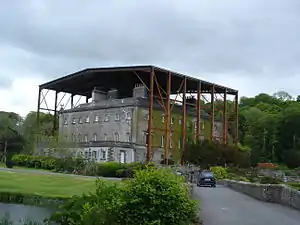
Music and performing arts
On 23 and 24 June 2012, the inaugural Westport Festival of Music and Performing Arts took place at Westport House.[10] Some of the acts that performed were Jools Holland, The Waterboys, Ryan Sheridan, Imelda May, Seasick Steve, Mundy, and Royseven.[11]
On 26–27 August 2017, Aiken Promotions used Westport House as one of two venues for the first Harvest Country Music Festival. Acts included headliners Miranda Lambert & Nathan Carter.
References
- https://www.bbc.com/news/world-europe-28301284
- "New owners to invest €50m in Westport House". RTE.ie. 27 January 2017. Retrieved 15 November 2017.
- "Archived copy" (PDF). Archived from the original (PDF) on 4 March 2016. Retrieved 7 October 2015.CS1 maint: archived copy as title (link)
- https://www.irishtimes.com/news/ireland/irish-news/historic-westport-house-is-facing-a-very-modern-threat-1.2377042
- https://www.irishtimes.com/culture/heritage/westport-house-sold-to-co-mayo-hotelier-1.2953599
- http://www.thejournal.ie/readme/irish-slaveowners-compensation-1587899-Jul2014/
- http://www.thejournal.ie/readme/irish-slaveowners-compensation-1587899-Jul2014/
- Westport House a Brief History, Westport House 2008
- "Sale of Westport House - Westport House". Westport House. 27 January 2017. Retrieved 20 November 2017.
- "Westport music festival announced". RTÉ Ten. Raidió Teilifís Éireann. 23 February 2012. Retrieved 23 February 2012.
- "Line up for Westport Music Festival 2012". Westport Music Festival. 23 February 2012. Retrieved 23 February 2012.
